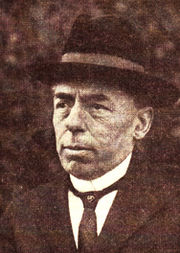
Josep Comas Solá
Encyclopedia
| Asteroid Asteroid Asteroids are a class of small Solar System bodies in orbit around the Sun. They have also been called planetoids, especially the larger ones... s discovered: 11 |
|
|---|---|
| 804 Hispania 804 Hispania 804 Hispania is a minor planet orbiting the Sun. It was discovered from Barcelona on 20 March 1915 by Josep Comas Solá , the first asteroid to be discovered by a Spaniard.-External links:*... |
March 20, 1915 |
| 925 Alphonsina 925 Alphonsina -External links:*... |
January 13, 1920 |
| 945 Barcelona 945 Barcelona - Introduction :It is an asteroid found on 3 February 1921 from Barcelona by the Catalan astronomer Josep Comas Solá . Its diameter is 25.5 km.... |
February 3, 1921 |
| 986 Amelia 986 Amelia 986 Amelia is a minor planet orbiting the Sun.-External links:*... |
October 19, 1922 |
| 1102 Pepita 1102 Pepita 1102 Pepita is a Main-belt asteroid. It was discovered by Josep Comas Solà at the Fabra Observatory in Barcelona, Spain, on November 5, 1928.Its name is the feminine form of Pepito, the discoverer's nickname.-External links:*... |
November 5, 1928 |
| 1117 Reginita 1117 Reginita 1117 Reginita is a main belt asteroid orbiting the Sun. It was discovered by Josep Comas Solá on May 29, 1927 at Barcelona, Spain. Its provisional designation was 1927 KA. It was named in honor of the niece of its observer. It completes one revolution around the Sun approximately once every 3 years... |
May 24, 1927 |
| 1136 Mercedes 1136 Mercedes 1136 Mercedes is a main belt asteroid orbiting the Sun. Approximately 25 kilometers in diameter, it makes a revolution around the Sun once every 4 years. It was discovered by Josep Comas Solá on October 30, 1929 in Barcelona, Spain. It was named for the sister-in-law of the discoverer. Its... |
October 30, 1929 |
| 1188 Gothlandia 1188 Gothlandia 1188 Gothlandia is a main-belt asteroid discovered on September 30, 1930 by Josep Comas Solà at Barcelona.- External links :**http://adsabs.harvard.edu/abs/2004PDSS....1...77B... |
September 30, 1930 |
| 1626 Sadeya 1626 Sadeya 1626 Sadeya is a main-belt asteroid discovered on January 10, 1927 by Josep Comas Solá at Barcelona. The asteroid was named after the Spanish and American Astronomical Society founded by Solá.- External links :*... |
January 10, 1927 |
| 1655 Comas Solà 1655 Comas Solá 1655 Comas Solà is a main belt asteroid with an orbital period of 1693.5024076 days . It has an average orbital speed of 17.85430271 km/s.The asteroid was discovered on November 28, 1929 at the Fabra Observatory.... |
November 28, 1929 |
| 1708 Pólit 1708 Pólit 1708 Polit is a main belt asteroid with an orbital period of 1819.5038072 days . The asteroid was discovered on November 30, 1929.-References:... |
December 1, 1929 |

Catalan people
The Catalans or Catalonians are the people from, or with origins in, Catalonia that form a historical nationality in Spain. The inhabitants of the adjacent portion of southern France are sometimes included in this definition...
Spanish
Spain
Spain , officially the Kingdom of Spain languages]] under the European Charter for Regional or Minority Languages. In each of these, Spain's official name is as follows:;;;;;;), is a country and member state of the European Union located in southwestern Europe on the Iberian Peninsula...
astronomer
Astronomer
An astronomer is a scientist who studies celestial bodies such as planets, stars and galaxies.Historically, astronomy was more concerned with the classification and description of phenomena in the sky, while astrophysics attempted to explain these phenomena and the differences between them using...
.
He observed planets including Mars
Mars
Mars is the fourth planet from the Sun in the Solar System. The planet is named after the Roman god of war, Mars. It is often described as the "Red Planet", as the iron oxide prevalent on its surface gives it a reddish appearance...
and Saturn
Saturn
Saturn is the sixth planet from the Sun and the second largest planet in the Solar System, after Jupiter. Saturn is named after the Roman god Saturn, equated to the Greek Cronus , the Babylonian Ninurta and the Hindu Shani. Saturn's astronomical symbol represents the Roman god's sickle.Saturn,...
, measuring the period of rotation of the latter. He wrote some books popularizing astronomy, and was first president of the Sociedad Astrónomica de España y América.
He discovered the periodic comet
Comet
A comet is an icy small Solar System body that, when close enough to the Sun, displays a visible coma and sometimes also a tail. These phenomena are both due to the effects of solar radiation and the solar wind upon the nucleus of the comet...
32P/Comas Solà
32P/Comas Solá
32P/Comas Solà is the name of a periodic comet with a current orbital period of 8.8 years.The comet nucleus is estimated to be 8.4 kilometers in diameter.-Discovery:...
, and co-discovered the non-periodic C/1925 F1 (Shajn-Comas Solá); he also discovered some asteroids.
The asteroids 1102 Pepita
1102 Pepita
1102 Pepita is a Main-belt asteroid. It was discovered by Josep Comas Solà at the Fabra Observatory in Barcelona, Spain, on November 5, 1928.Its name is the feminine form of Pepito, the discoverer's nickname.-External links:*...
(from his nickname Pepito) and 1655 Comas Solà
1655 Comas Solá
1655 Comas Solà is a main belt asteroid with an orbital period of 1693.5024076 days . It has an average orbital speed of 17.85430271 km/s.The asteroid was discovered on November 28, 1929 at the Fabra Observatory....
are named after him.
In 1907 he claimed to observe limb darkening of Saturn's moon Titan
Titan (moon)
Titan , or Saturn VI, is the largest moon of Saturn, the only natural satellite known to have a dense atmosphere, and the only object other than Earth for which clear evidence of stable bodies of surface liquid has been found....
, the first evidence that the body had an atmosphere.
He was the director of Fabra Observatory
Fabra Observatory
The Fabra Observatory is an astronomical observatory located in Barcelona, Catalonia, pointed towards the south at 415 m of altitude over the level of the sea ....
since it was established in 1904.

